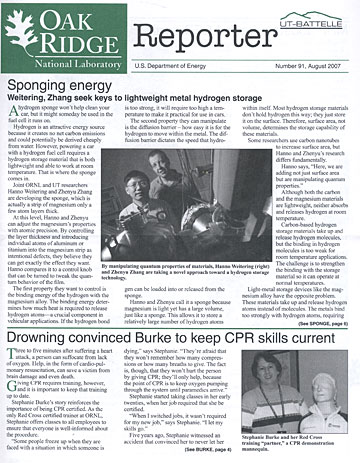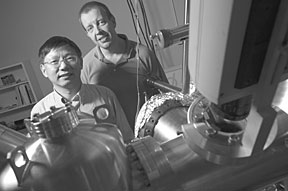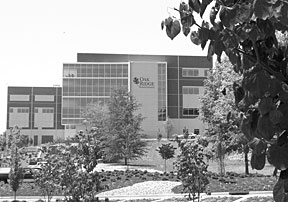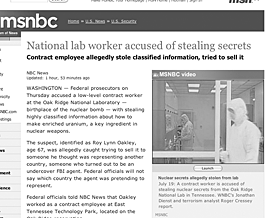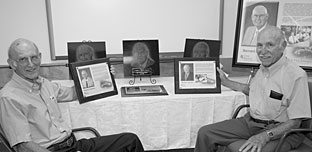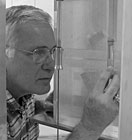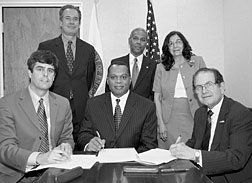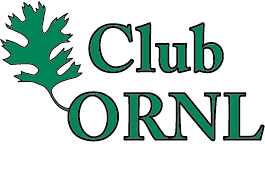 |
Number 91, August 2007 |
 Sponging energy
Sponging energy
Weitering, Zhang seek keys to lightweight metal hydrogen storage
|
|
By manipulating quantum properties of materials, Hanno Weitering (right) and Zhenyu Zhang are taking a novel approach toward a hydrogen storage technology. |
A hydrogen sponge won’t help clean your
car, but it might someday be used in the fuel cell it runs on.
Hydrogen is an attractive energy source because it creates no net carbon emissions and could potentially be derived cheaply from water. However, powering a car with a hydrogen fuel cell requires a hydrogen storage material that is both lightweight and able to work at room temperature. That is where the sponge comes in.
Joint ORNL and UT researchers Hanno Weitering and Zhenyu Zhang are developing the sponge, which is actually a strip of magnesium only a few atom layers thick.
At this level, Hanno and Zhenyu can adjust the magnesium’s properties with atomic precision. By controlling the layer thickness and introducing individual atoms of aluminum or titanium into the magnesium strip as intentional defects, they believe they can get exactly the effect they want. Hanno compares it to a control knob that can be turned to tweak the quantum behavior of the film.
The first property they want to control is the binding energy of the hydrogen with the magnesium alloy. The binding energy determines how much heat is required to release hydrogen atoms—a crucial component in vehicular applications. If the hydrogen bond is too strong, it will require too high a temperature to make it practical for use in cars.
The second property they can manipulate is the diffusion barrier – how easy it is for the hydrogen to move within the metal. The diffusion barrier dictates the speed that hydrogen can be loaded into or released from the sponge.
Hanno and Zhenyu call it a sponge because magnesium is light yet has a large volume, just like a sponge. This allows it to store a relatively large number of hydrogen atoms within itself. Most hydrogen storage materials don’t hold hydrogen this way; they just store it on the surface. Therefore, surface area, not volume, determines the storage capability of these materials.
Some researchers use carbon nanotubes to increase surface area, but Hanno and Zhenyu’s research differs fundamentally.
Hanno says, “Here, we are adding not just surface area but are manipulating quantum properties.”
Although both the carbon and the magnesium materials are lightweight, neither absorbs and releases hydrogen at room temperature.
Carbon-based hydrogen storage materials take up and release hydrogen molecules, but the binding in hydrogen molecules is too weak for room temperature applications. The challenge is to strengthen the binding with the storage material so it can operate at normal temperatures.
Light-metal storage devices like the magnesium alloy have the opposite problem. These materials take up and release hydrogen atoms instead of molecules. The metals bind too strongly with hydrogen atoms, requiring lots of heat to release them.
Zhenyu says the international community has not reached a consensus yet about which material is best for storing hydrogen. Even if scientists decide on something different, he says his and Hanno’s research has many potential energy applications beyond hydrogen storage because of what it teaches them about controlling materials’ properties at the atomic level.
They recently received a DOE grant to further study hydrogen applications of the magnesium nanofilm.
Hanno says this project is a great example of the value of the ORNL-UT partnership. The exploration of quantum films began as a Laboratory Directed Research and Development grant back in 1998. Later on, National Science Foundation grants funded it, and it was located mostly at UT-Knoxville. Now it is coming back to the Lab with DOE money from the President’s Hydrogen Fuel Initiative.
“It’s a win-win situation for both UT and the Lab,” Hanno says, “For UT, it’s fantastic for faculty to have all the resources the Lab has to offer, both facilities and expertise. On the flip side, ORNL can reach out to grad-students and post-docs through NSF funding that UT gets.”
“The main factor to a clean hydrogen economy seems to be economic incentives. I don’t see a fundamental obstacle at this point.” |
|---|
Hanno says it is the first research of its kind at ORNL as far as he knows, and Zhenyu hopes the work can help lead to more hydrogen energy research at the Lab.
Their future research will focus on gaining further control over the properties of the magnesium film. However that research turns out, they say it will not provide the final solution to hydrogen storage.
“It’s not going to be a practical system,” Hanno says, “They (the magnesium strips) have a very small volume so you can’t store a lot of hydrogen.”
He says that in an ideal energy world you would use the sun’s energy to split water into hydrogen atoms and then use hydrogen in a fuel cell to generate energy, which would create water as a byproduct. That clean energy future is still far away.
“I find it hard to predict when we will have a clean hydrogen economy. The main factor seems to be economic incentives. I don’t see a fundamental obstacle at this point,” Hanno says.
Both scientists hope this research will yield some unpredicted new ideas about atomic manipulation, even if they are different from what they have proposed.
“If everything turns out the way you propose, it’s really boring and not very good science,” Hanno says. “If your ideas are any good, you will always be surprised by something.”—Charlie Smith ![]()
 Drowning convinced Burke to keep CPR skills current
Drowning convinced Burke to keep CPR skills current
|
|
Stephanie Burke and her Red Cross training “partner,” a CPR demonstration mannequin. |
Three to five minutes after suffering a heart attack, a person can suffocate from lack of oxygen. Help, in the form of cardio-pulmonary resuscitation, can save a victim from brain damage and even death.
Giving CPR requires training, however, and it is important to keep that training up to date.
Stephanie Burke’s story reinforces the importance of being CPR certified. As the only Red Cross certified trainer at ORNL, Stephanie offers classes to all employees to ensure that everyone is well-informed about the procedure.
“Some people freeze up when they are faced with a situation in which someone is dying,” says Stephanie. “They’re afraid that they won’t remember how many compressions or how many breaths to give. The fact is, though, that they won’t hurt the person by giving CPR; they’ll only help, because the point of CPR is to keep oxygen pumping through the system until paramedics arrive.”
Stephanie started taking classes in her early twenties, when her job required that she be certified.
“When I switched jobs, it wasn’t required for my new job,” says Stephanie. “I let my skills go.”
Five years ago, Stephanie witnessed an accident that convinced her to never let her training slide again.
That day, Stephanie and her family and friends were at Fort Loudoun lake for a friend’s marriage party. A woman approached the party, searching frantically for her children, a four-year-old and a six-year-old, who were missing. Stephanie and some others helped her search.
The children were found face down and unconscious in the water of a swimming area. Stephanie, who did not
hold her certification anymore, couldn’t do anything to help them. Fortunately, an off-duty emergency medical technician and her husband were also at the lake. They managed to revive the four-year-old, but the six-year-old did not survive.
“All I could do was comfort the mother,” remembers Stephanie, “and I tell you, there isn’t any comfort to be given in that situation.” That day, Stephanie resolved to never let her training slip again. She signed up for the next available class when she went to work that Monday.
Stephanie says the experience haunted her, and she eagerly took the chance to be a
certified trainer when it was offered to her by former ORNL training officer Jeff
Kirkham. Last year, she broke a record for the Red Cross Appalachian Chapter by teaching 75 classes.
The Red Cross chapter recently recognized her for her service.
About half of the people in each class are taking it because it is required. The other half take it because they want to know. |
|---|
Stephanie stresses the importance of keeping up CPR certification. A CPR certification lasts for one year, while a basic First Aid certification lasts for three. Stephanie teaches classes at ORNL on a regular basis for CPR, CPR-AED (automated external defibrillation) and first aid classes.
“About half of the people in each class are taking it because it is required,” she says. “The other half take it because they want to know.” Small class sizes and equipment such as dolls and training AEDs make the experience very informative and enjoyable.
The classes are open to everyone, and the costs of training are usually covered by the division. Stephanie says she tries to be accommodating to the needs of groups.
“I’ve even done classes late in the evening,” she says.
Interested parties can sign up online by going to the internal home page and clicking on “Training” under “Lab Services.” Then click on the light blue box that reads “Classroom Event Schedule.” Click on “Class/Event offerings” to view the class schedule; then click on the event number to sign up.
Or contact Stephanie at 576-9478 to sign up for a class.
“The likelihood of the victim being a co-worker or a loved one is high,” says Stephanie. “Every minute counts.”—Whitney Downing ![]()
This month’s ORNL Reporter includes stories by Charlie Smith, the Communications & External Relations’ summer intern from the University of Tennessee’s science writing program, and Whitney Downing, who is participating with the Research Alliance in Math and Science program from Maryville College.
 MRF added to Lab’s LEED certified, green buildings
MRF added to Lab’s LEED certified, green buildings
|
|
The Multiprogram Research Facility is the first ORNL facility to earn the LEED gold rating. |
The Multiprogram Research Facility has earned the gold certification from the Leadership in Energy and Environmental Design, or LEED, green building rating system from the U.S. Green Building Council. One of six LEED-certified buildings at ORNL, the MRF is the newest in the east campus construction campaign and the Lab’s second major privately funded facility.
All of the new buildings on the east campus are LEED certified; the MRF is the first to attain the gold rating, says the Facilities Development Division’s Keith Dempsey. The U.S. Green Building Council offers four degrees of LEED certification: certified, silver, gold and platinum.
“ORNL’s new construction represents approximately three-quarters of a million square feet of LEED-certified space and should be a real source of pride for the Lab,” Keith says.
LEED standards promote a whole-building approach to sustainability by recognizing performance in five areas of human and environmental health: sustainable site development, water savings, energy efficiency, materials selection and indoor environmental quality.
“Design and construction of the MRF were particularly demanding because of its complex mixture of uses with stringent operational, security, environmental and energy requirements, and required a significant team effort of the contractors, developer, architectural-engineering and ORNL staff ,” Keith says.
|
|
Hybrid lighting system solar collectors sprout from the MRF’s rooftop. |
The MRF presented a unique set of challenges to the design and construction team because its ultimate use required detailed and stringent technical parameters. The project had to be fast-tracked so that portions of the building could be completed and approved in time to install
specialized equipment.
Nevertheless, the facility came in on time and on budget and within the LEED gold requirements.
Environmental sustainability was a primary objective throughout the MRF’s design and construction, from site preparation through finishing and furnishing the interior.
The five-floor building’s vertical orientation minimizes the building’s footprint on the landscape, and 12 percent of its wall space is underground. Building materials contain 28 percent recycled content on average, and 83 percent of the materials are manufactured within 500 miles, reducing transport impacts. Construction waste was recycled wherever possible; for example, gypsum wallboard waste was donated to local farmers or used on site to amend soil.
The MRF uses about 25-percent less energy than a standard code-compliant facility. Energy-saving design features include light-colored roofs, high-performance glass, high-efficiency mechanical and electrical equipment and layout, 95 percent efficient condensing natural gas boilers, lighting controls, elimination of 75 percent of the glazing in one of the building sections and automatic HVAC setback controls.
Hybrid solar lighting systems with rooftop solar collectors are installed to demonstrate the feasibility of solar collection and fiber optic distribution of natural light.
An energy analysis of the six LEED-certified east campus buildings shows dramatic savings in energy consumption and energy costs during FY 2006 compared with older ORNL buildings. Factoring out the computer center, energy use per gross square foot in the new facilities was 54.6 percent lower than for the 50-year-old 4500-North complex, which is a combination office-lab facility.
Monetarily speaking, the six LEED buildings’ energy cost savings is about 42 percent when compared with all other ORNL non-process facilities. As the gold-certified building in the group, the MRF’s performance will be even better, with energy cost savings approaching 50 percent.—B.C. ![]()
 Benefits Service Center moves
Benefits Service Center moves
The Benefits Service Center (including OneCall) has moved to 602 Scarboro Road from its former Union Valley Road location. The center’s new office is just outside the main entrance to the Y-12 facility in the New Hope Center.
The center’s days of operation have also changed. The service center will be open for walk-in customers from 8 a.m. to 4 p.m. on Monday through Thursday. OneCall telephone service will be provided from 7 a.m. to 5 p.m. on those same days. Phone numbers remain (865) 574-1500 or 1-877-861-2255.
 |
 Another case of mistaken identity
Another case of mistaken identity
The first reports hit the news Web sites around 10 on the morning of July 19. Sample streamer: “Oak Ridge Lab’s Nuclear Secrets Stolen.” According to the story breathlessly broken by a New York City TV station, a man whose job was to “escort visitors to and from offices at the lab” but who also “performed maintenance work” (a curious skill mix) had stolen “classified information about the uranium enrichment process.”
The practice of journalism revolves around the five Ws: who, what, when, where and why. In this case particular insult was dealt to the fourth W: ORNL was not associated with the alleged crime, the accused or the type of work described.
|
|
Unrelated: And just for effect, run it with a stock photo from the nanoscience center. |
The by-then-viral story was picked up by nearly every news network, none of which apparently fact-check competitors’ stories before jumping aboard.
There was creativity: One cable network placed the accused’s residence in a trailer on the ORNL grounds.
Nevertheless, the Lab’s past efforts to point out the distinctions between the Oak Ridge sites and missions seems to have paid off. By early afternoon some news outlets were correcting their stories, particularly local media. By 6 p.m., the local TV stations were even making the Lab’s misidentification an element of the story, as did some national networks.
But some of the cable networks never bothered to correct their stories.
It matters, as Lab Director Thom Mason said in a recent staff e-mail, because “inaccurate reports of poor operational performance can harm our perception with our customer, with policymakers and with the public.”
Even, or maybe especially, inaccurate reports.
 Bringing remote sensing to school
Bringing remote sensing to school
Linda Radcliffe is helping bring remote sensing science from ORNL to children in science classes.
The ecology and environmental sciences teacher at Bearden High School has worked at ORNL for three summers through the Academy for Creating Teacher Scientists developing a curriculum that schools can use to teach students about remote sensing via satellites.
She recently gave a multimedia presentation about satellites and remote-sensing data for elementary school children at the American Museum of Science and Energy to help publicize their “Eyes on the Earth” exhibit.
Suresh Kumar, a scientist in the Environmental Sciences Division, helped her with scientific aspects of the presentation. Suresh creates databases for scientists from satellite data at the Distributed Active Archive Center, a NASA program that compares satellite data with information from the ground, he says.
Linda showed images from one of the first remote satellites, pigeons with cameras strapped on to their bodies, along with present-day pictures from 200 miles above the Earth. Radcliffe said the more than 600 satellites in operation today provide valuable information about cloud patterns, wildfires, global temperatures and pollution levels.
For example, NASA’s CALIPSO
weather satellite, which Suresh helped create
technology for, uses infrared imaging to
alert South Africans about fires that often destroy communications and power lines there.
 HFIR hosts families, honors veterans
HFIR hosts families, honors veterans
|
|
Dick Cheverton (left) and Rube McCord were honored on HFIR’s family day, along with Bernie Corbett, whose display is behind Rube. |
The High Flux Isotope Reactor’s Family Day on Saturday, July 21, gave HFIR employees a chance to show off the reactor’s new capabilities. HFIR staff members gave tours of the control and beam rooms and took their families around to see their offices throughout the HFIR campus.
HFIR management renamed the control room after Dick Cheverton, the leader of the original HFIR design team, and two conference rooms after former HFIR managers Bernie Corbett and Rube McCord. Ron Crone, Research Reactors Division director, presented Cheverton and McCord with plaques honoring their achievements.
Cheverton said when he first presented the idea for HFIR to then-Lab Director Alvin Weinberg, Weinberg said, “That’s the most hare-brained idea I have ever heard.”
Cheverton was unaware that the Lab was in competition with the concept he had proposed for HFIR.
Luckily for Cheverton—and the families of the people who still work at HFIR over 40 years later—they altered the design and the U.S.’s highest flux reactor-based source of neutrons was built, with the late director as one of its biggest proponents.
—Reported by Charlie Smith |
 New spectrometer expands HTML’s analytical reach
New spectrometer expands HTML’s analytical reach
|
|
Harry Meyer runs tests on the newly installed X-ray photoelectron spectrometer at the High Temperature Materials Laboratory. |
A new X-ray photoelectron spectrometer at
the High Temperature Materials Laboratory gives ORNL another weapon in its materials science arsenal.
The $450,000 K-Alpha XPS system by Thermo Fisher Scientific analyzes the surface of materials to determine what elements are present and how those elements are bound together chemically.
Harry Meyer from the Materials S&T
Division’s Microscopy group says the machine will have applications in diverse areas such as catalysis, fuel cell materials development, analysis of new materials and photovoltaic research.
XPS works by focusing an X-ray beam onto a material. The photons in the X-rays excite electrons on the surface, releasing the electrons.
“When X-ray photons hit the sample, they transfer energy to electrons. Some of the excited electrons get ejected,” Harry says.
The emitted electrons possess a unique amount of energy when they are released depending on what element they come from. Therefore, measuring the electrons’ kinetic energy tells what elements are present on the surface.
Since the device looks at the top few layers of a material’s surface—its information depth is only 30 to 50 angstroms deep—measurements must be made inside an ultra-high vacuum so water, carbon dioxide or other molecules in the air don’t pollute the surface.
Harry wants users from throughout ORNL to take advantage of the XPS.
“Materials characterization should be a resource to people doing materials development. We want people to start clamoring to come and use it,” he says.
The diesel engine maker Cummins will be one of the first users of the instrument, and Harry anticipates the technology being useful to ORNL colleagues such as researchers studying nano-materials synthesis at the Center for Nanophase Materials Sciences.
He also has work lined up on fuel cell materials research, including a DOE Office of Energy Efficiency and Renewable Energy funded project aimed at developing new polymer electrolyte membrane materials. Because the surface chemistry of the membrane dictates its performance, the K-Alpha XPS is perfectly suited for its characterization. In particular, the information provided by the K-Alpha will show how well new processing steps are working in preparing these alternative polymer membranes.
HTML had XPS capabilities a decade ago, but the instrument never ran well and was eventually sold. Harry says researchers have gotten by using other techniques less suited to what they are doing, but that the new XPS machine, which is on consignment for a year, will vastly improve the Laboratory’s surface analysis capabilities.—Charlie Smith ![]()
 Blood work, ‘electrons in morning’ boost RETF
Blood work, ‘electrons in morning’ boost RETF
|
|
Jim Bogard inserts a test tube in a plastic anthromorphic phantom for neutron irradiations of blood. |
Mark Jenkins walks into the X-ray room at the Radiation Effects
Test Facility holding a glass tube filled with blood.
“Do you smell electrons?” Gordon Livingston, Jenkins’s colleague at ORAU, asks as Jenkins hands the tube to Jim Bogard, who places it into a slit in a plastic phantom in front of the X-ray source.
“Yeah,” Jenkins says. “I love the smell of electrons in the morning.”
He and Livingston are exposing human blood to different amounts of radiation to determine how much white blood cell mutations increase as radiation levels increase.
Jim Bogard, the Dosimetry Applications Research program leader at ORNL, runs the
X-ray machine at RETF during the experiments. He has also irradiated blood for the ORAU experimenters using the facility’s gamma ray and neutron sources.
After irradiating the blood, Jenkins and Livingston take it back to ORAU where it is cultured and stimulated to divide. Two days later, chromosomal abnormalities are observed by a scanning microscope.
The results will establish a relationship between radiation dose and biological response. In the event of a radiological exposure, ORAU’s Radiation Emergency Assistance Center can calculate the radiation dose a person received based on the number and type of chromosome abnormalities present in their blood. Doctors can then treat the patients accordingly.
Jim says the terrorist attacks of September 11 renewed interest in radiation dosimetry, which had waned after the Cold War’s end. The RETF has seen a corresponding increase in use.
“This lab has really been underutilized for the last 10 years, but things have started to pick up,” Jim says.
Current research at the lab includes an effort by ORNL scientist Clay Easterly to use tooth enamel as a natural dosimeter and a Mouse House cancer-onset study of a liver enzyme in mice.
Jim co-authored a poster with Jenkins and
Livingston about the experiments that they presented in July at the 52nd annual meeting of the Health
Physics Society.—Charlie Smith
 ORNL, Morehouse College sign mentoring pact
ORNL, Morehouse College sign mentoring pact
A new joint initiative between ORNL and
Morehouse College will assist students in the college’s science programs and promote research collaboration at both institutions.
The ORNL-Morehouse Mentor Protégé Agreement—the first such agreement between a historically black college or university and an Office of Science lab—was recognized July 27 in a brief ceremony at DOE headquarters in Washington, D.C.
|
|
Present at the ORNL and Morehouse College ceremony honoring their mentor-protégé agreement were (from left) ORNL Director Thom Mason; William Valdez, Office of Science; Morehouse College Vice President Phillip Howard; James Page Brown, Morehouse College; Theresa Alvillar-Speake, director, DOE Office of Minority Economic Impact; and Under Secretary for Science Raymond L. Orbach. |
Raymond L. Orbach, DOE’s Under Secretary for Science and Director of Science, said the event marks an important relationship between DOE and an Historically Black College and University (HBCU), one of mutual respect and support. Other key DOE programs include the Research Alliance in Mathematics and Science at ORNL and Directly Funded Universities.
“Improving research and educational opportunities for students traditionally underrepresented in science is important to DOE, and to our nation,” Orbach said. “Teaming a leading U.S. liberal arts college with a leading Office of Science laboratory is an educational initiative that will help produce the scientific workforce our country needs for intellectual and economic leadership in the 21st century.”
ORNL Director Thom Mason said the Morehouse connection will help ORNL’s work force pipeline for recruiting young talent and promote research collaborations.
“ORNL is a world class science laboratory, and we consider a strong commitment to diversity to be an integral part of that world class designation,” Thom said. “We are very pleased to establish this relationship with such an outstanding academic institution and look forward to a long and mutually beneficial relationship with Morehouse.”
ORNL mentors in the program include Martin Keller, director of the DOE Bioenergy Science Center established in June by a $125 million DOE award, and Jeff Nichols, director of Computer Sciences and Mathematics in the Computing and Computational Sciences Directorate.
A recent Wall Street Journal study ranked the Atlanta college among the top 50 feeder schools to the nation’s best graduate programs in business, medicine and law.
Morehouse has been ranked No. 1 three times in a row by Black Enterprise Magazine as the best school for African Americans for undergraduate study. The school has often been dubbed the “black Harvard University” or “Harvard of the South.”
College connections with DOE and ORNL include former Morehouse President Walter Massey, who retired June 30, who also headed the National Science Foundation and Argonne National Laboratory, and J.P. Brown, director of Morehouse’s Office for Research Careers, who conducted postdoctoral studies at ORNL in biochemistry and is among several of the college’s employees with ORNL connections.
ORNL’s Mentor-Protégé Program is part of a DOE initiative designed to encourage and help small businesses perform contracts and subcontracts for ORNL. In addition to HBCUs and minority educational institutions, program participants include small disadvantaged businesses, and those owned by women or service-disabled veterans.—Mike Bradley ![]()
 She has a way with birds
She has a way with birds
Courtyard’s hummingbirds find a friend in Pam Golden
|
|
One woman at ORNL finds joy not in new scientific discoveries, but in what is already provided
by nature.
“I was cleaning windows one day, and there they were,” says Pam Golden, a facility caretaker at ORNL. Golden saw hummingbirds. She began putting hummingbird feeders outside of the building where she worked, then the Experimental Gas-Cooled Reactor, Building 7601. When she was moved to the Conference Center, the hummingbirds and their feeders moved with her. Pam now works in the Research Office Building, and the hummingbird feeders and their patrons reside in the courtyard outside of Main Street.
Pam has kept hummingbird feeders at her house for the past 10 years. She says the same birds come back to her feeders every season.
“I don’t name them or anything,” she says, “but you can tell which ones are which if you watch them long enough.”
Pam supplies her birds at home and at ORNL with a blend of sugar and water. She fills a saucepan with water and scoops a mound of white sugar in the middle.
“I never measure,” she laughs. “I guess it’s about four or five cups.” Pam then boils the mixture for an hour, until it becomes a syrup. She says that the sugar water lasts about a week in her refrigerator.
|
|
“I change the water in the feeders every day, especially in the summer,” she says. “If I don’t, the mix will go sour in the heat, and the birds can get sick from it.” When Pam is not at work, a friend in the adjacent Engineering Technology Facility changes the sugar water for the ORNL hummingbirds.
The most common variety of hummingbird in East Tennessee is the ruby-throated hummingbird.
Pam says the birds are very curious and friendly creatures and will fly around her when she is out in her
garden.
Pam hopes that everyone at ORNL enjoys the resident hummingbirds as much as she does.
“They say that having pet fish will lower your blood pressure,” she says. “I believe the same thing is true with these wild hummingbirds.”—Whitney Downing ![]()
 United Way 2007: ‘Extraordinary’
United Way 2007: ‘Extraordinary’
Extraordinary giving by Extraordinary
people” is the theme for the 2007 ORNL United Way campaign, headed by chair Karen Downer and co-chair Jimmy Stone. The goal for this year’s drive—which continues through mid-September—is an ambitious $825,000.
ORNL Director Thom Mason helped kick off the drive with a special message to employees, in which he thanked them for their generosity and commitment. “If you already give to United Way, you can be proud of what your contributions are achieving in our community,” he said. “I encourage you to consider increasing your contribution to reflect ORNL’s continuing success and growth and to assist us in reaching this year’s goal. If you are not a United Way contributor, I hope you will join me and thousands of your co-workers in this investment in our community,” Mason added.
This year’s campaign events include a late-August rally featuring UT men’s basketball coach Bruce Pearl, an agency fair, Lifestyle Discounts book sales, the International Festival and Leadership Givers breakfast in September and two book fairs. See the September issue of Reporter for more information on the Bruce Pearl visit and other campaign activities. Additional United Way information may be found at home.ornl.gov/general/united_way/index_2.shtml. ![]()
 Fred Young, SSD director, dies
Fred Young, SSD director, dies
Fred Young , 82, former director of the Solid State Division and a scientist internationally known for pioneering investigations of the effects of nuclear radiation on materials and for his leadership in materials science research at ORNL, died at his home in Knoxville August 2. He retired in December 1990.
Dr. Young’s research included groundbreaking investigations in several areas involving the effects of nuclear radiation on metals.
He pioneered experiments to determine the effects of irradiation-induced defects on chemical processes such as surface oxidation and chemical etching, and he used a variety of new techniques to analyze and characterize the introduction, arrangement and annealing of radiation-induced defects.
He was a fellow of the American Physical Society and the American Association for the Advancement of Science and was the author or co-author of 263 scientific papers. ![]()
 New Staff
Members
New Staff
Members
John Michael Canik, Fusion Energy
Jennifer Ann Harvey, Audit & Oversight Dir.
Rebecca Ashley Mills and Jennifer Lynn Niedziela, Neutron Scattering Science
Ray Edwin O’Neal and Thomas Edward Hanlon, Research Accelerator
Kevin Lee Redden, James Larkin Mullins, Larry Allen Beeler, Jason Buckhannan
Lainhart and John Michael Kyle, Craft Resources
Douglas Neal Collins, Quality Systems & Services
William Brian Weston and Donald Stuart Wilder, Research Reactors
Lindsey Diane Aloisi, Nuclear Technology Program Office
Matthew Steven Disney, Center for Computational Sciences
Patricia Ann Grisham and Leslie Gayle Ornduff, Business & Information
Services Dir.
Andrew James Church and Thorwald Leon Van Vuure, NScD Neutron Scattering
Science
Dwayne David Haskell and Brandon L. Coday, NScD Research Reactors
Robert Allen McNaughton, Contracts
Amy Nicole Rose, Computational Sciences & Engineering
Dawn Marie Levy, Communications & External Relations Dir.
Deanna Lynn Pickel, Center for Nanophase Matl’s Sciences ![]()
 ORNL People
ORNL People
|
|
Maksymovych |
Peter Maksymovych, a new Wigner Fellow working in the Materials S&T Division’s NanoTransport Lab, has won the highly sought Nottingham Prize, announced at the Physical Electronics Conference in June. Peter was selected in intense competition with 19 other recent top graduates. His presentation, based on his thesis work, was titled “Nonlocal Hot Electron Surface Chemistry in Scanning Tunneling Microscope.”
|
|
Rearden |
Brad Rearden of the Nuclear Science & Technology Division’s Radiation Transport and Criticality group is the 2007 recipient of the American Nuclear Society’s Landis Young Member Engineering Achievement Award. Brad is nationally and internationally recognized for his expertise and significant contributions in the implementation of sensitivity and uncertainty methods into Monte Carlo nuclear analysis codes. Brad received the award at the ANS annual meeting in June.
Tom Ballard has been named interim director of Technology Transfer and Economic Development. Tom, who directs TTED’s Economic Development and Partnerships operation, will continue in that role. Tom will lead TTED until a permanent replacement is found for Alex Fischer, who moved to Battelle’s Columbus office as vice president for commercialization.
Steve Zinkle, director of the Materials S&T Division, received the IEEE Nuclear and Plasma Sciences Society’s 2006 Fusion Technology Award during the 22nd Symposium on Fusion Engineering. Steve was recognized for his “outstanding contributions to the understanding of radiation effects in structural materials and exceptional leadership in the U.S. fusion materials program.” Previous ORNL recipients of this award include Fusion Energy Division’s Brad Nelson (2005) and Stan Milora (1991). Steve was also recently elected a Fellow of the American Nuclear Society, “for his outstanding contributions to the advancement of nuclear science and engineering.” In addition, Steve was selected to receive the American Nuclear Society’s 2007 Mishima Award, “for his pioneering contributions to our understanding of radiation effects in metals and ceramics for fission and fusion energy systems.”
Stacy C. Davis, a member of the Center for Transportation Analysis in the Engineering Science and Technology Division, has received a committee appointment from the Transportation Research Board Executive Committee to serve a one-year term on the Committee on Transportation Energy and Alternative Fuels. The TRB is a division of the National Research Council, a private, nonprofit institution that provides expertise in science and technology to the government, the public and the scientific and engineering communities.
